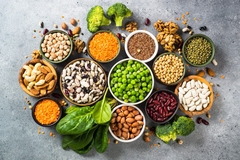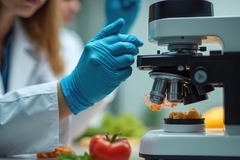
- Industry news
Industry news
- Category news
Category news
- Reports
- Key trends
- Multimedia
- Journal
- Events
- Suppliers
- Home
- Industry news
Industry news
- Category news
Category news
- Reports
- Key trends
- Multimedia
- Events
- Suppliers
Novozymes launches Enzyme Solution to Reduce Acrylamide

Acrylamide can be effectively reduced by removing asparagine from starchy foods with the enzyme asparaginase, as it converts asparagine into another common amino acid, aspartic acid.

31/08/07 Novozymes has launched Acrylaway, a new enzyme solution that reduces acrylamide in baked and fried starchy foods without altering the appearance and flavor of the final product. Acrylamide is a potential carcinogen that is formed when starchy foods are baked or fried at high temperatures.
Acrylaway is an asparaginase that reduces acrylamide levels by up to 90% without changing the appearance or taste of the final product. It can be used in a broad range of foods such as biscuits, cookies, crackers, crisp and toasted bread, and fried and baked starchy snacks.
“Acrylaway has been tested in Novozymes’ bakeries, at independent institutes and in the industry on a variety of food products, and all results show that acrylamide is substantially reduced and the end product’s flavor, look and feel is not affected,” says Anett Lund-Nielsen Colstrup, Global Product Launch Manager at Novozymes.
The main mechanism for acrylamide formation in starchy food involves reducing sugars and the amino acid asparagine, both common to these foods. The sugar reacts with asparagine when the starch is heated and through a cascade of reactions, the side chain of asparagine is converted into acrylamide. Acrylamide can be effectively reduced by removing asparagine from starchy foods with the enzyme asparaginase, as it converts asparagine into another common amino acid, aspartic acid.
Acrylamide is the product of a Maillard reaction between the amino acid asparagine and a variety of reducing sugars. Maillard reactions, also known as non-enzymatic browning, typically occur at temperatures above 100°C and are responsible for important color and flavor development in fried and baked starch products.
“The process that gives the delicious brown crust and fried or baked flavor also causes acrylamide. But with Acrylaway since only asparagines is converted, all other ingredients are still part of the Maillard reaction. So you keep the crust and taste, and substantially reduce the acrylamide,” says Anett Lund-Nielsen Colstrup.
Food manufacturers are showing interest in Acrylaway, especially in its ability to reduce acrylamide without altering their finished product.
“The food industry cares about acrylamide and we’ve worked with many of the industry players during the development of Acrylaway,” says Andrew Fordyce, Marketing Director Cereal Food at Novozymes. “This is an exciting product launch for us. Acrylaway is an excellent product that works very well to make food safer and healthier.”
As the first company ever, Novozymes received a consent letter from the US Food & Drug Administration regarding the generally recognized as safe (GRAS) status of the asparaginase enzyme in November 2006. In June 2007 Acrylaway received regulatory approval from the Danish authorities and thereby is the first asparaginase that has been through an active safety evaluation by a national EU authority. Furthermore, Acrylaway became the first asparaginase product to be evaluated internationally as it received a positive evaluation at the JECFA (Joint FAO/WHO Expert Committee on Food Additives) meeting in June 2007.











